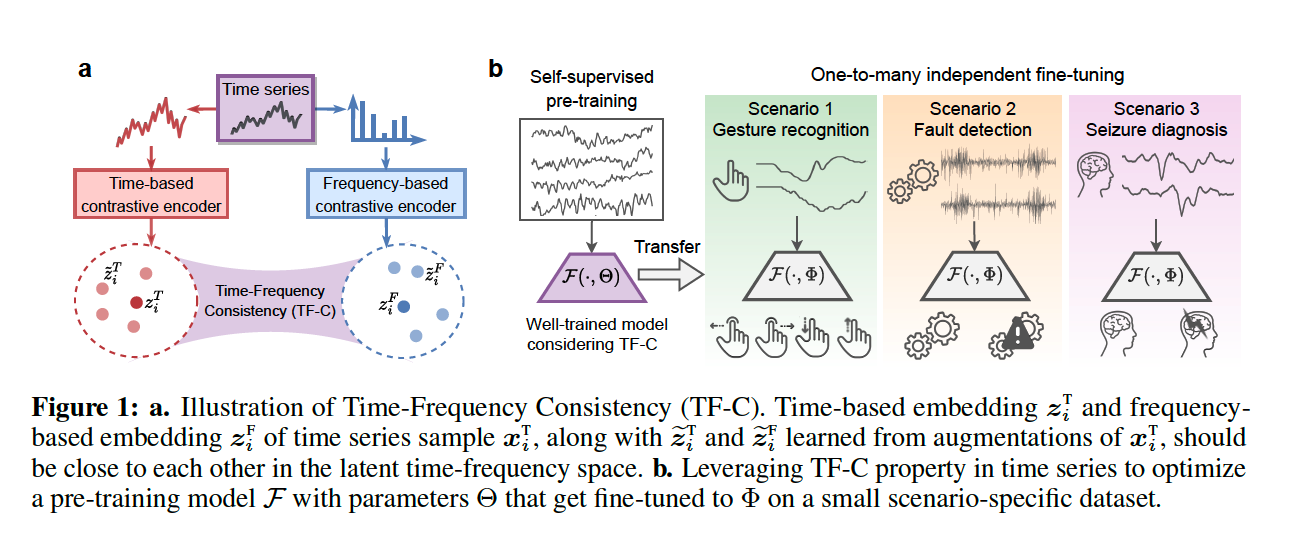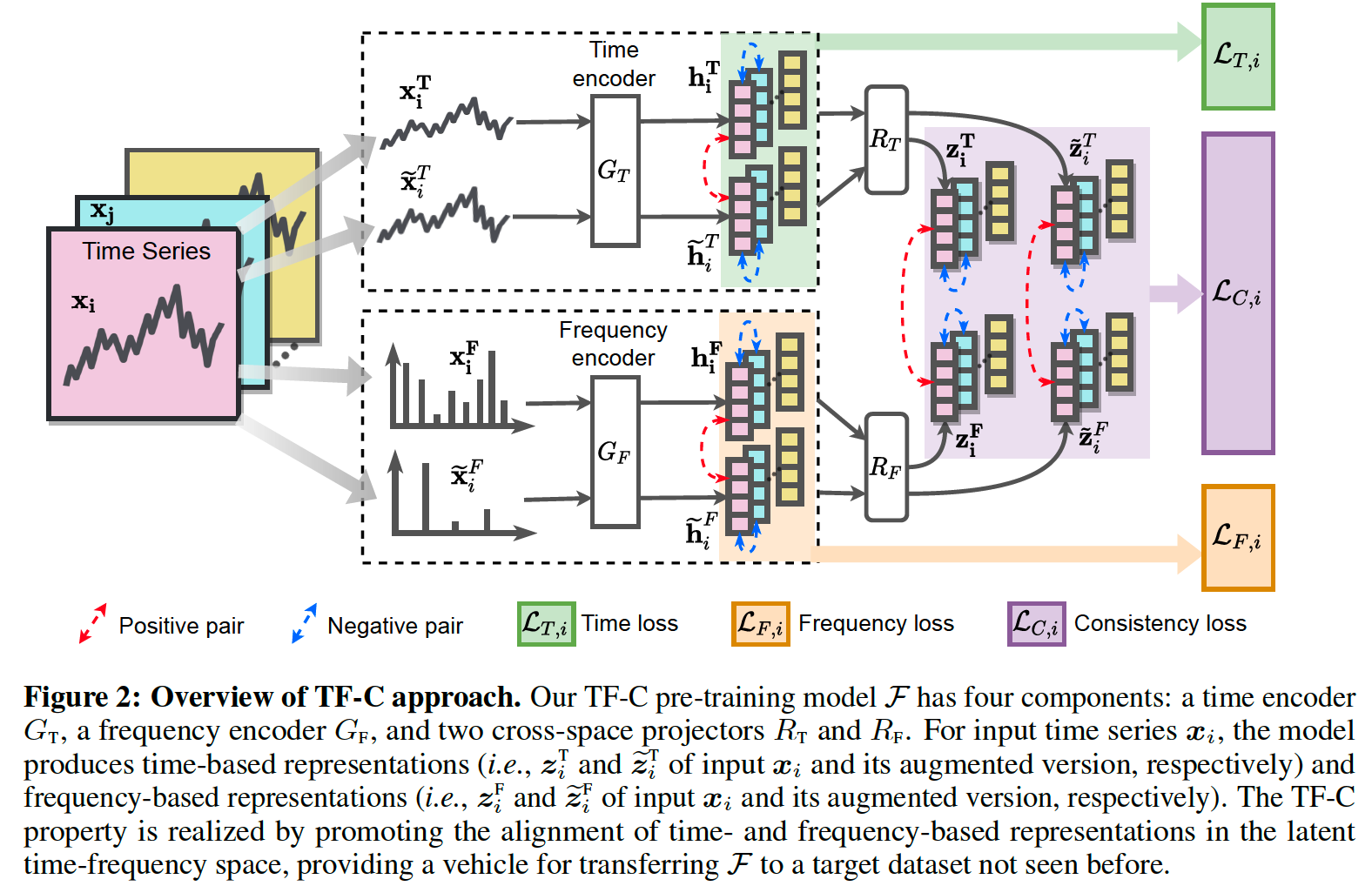Self-Supervised Contrastive Pre-Training For TS via Time-Frequency Consistency
Contents
- Abstract
- Introduction
- Related Work
- Pre-training for TS
- Contrastive Learning with TS
- Problem FOrmulation
- Our Approach
- Time-based Contrastive Encoder
- Frequency-based Contrastive Encoder
- Time-Frequency Consistency
- Implementation and Technical Details
0. Abstract
Pre-training in TS domain :
- need to accommodate target domains with different temporal dynamics
Expect that time-based and frequency-based representations of the same example :
\(\rightarrow\) located close together in the time frequency space
Time-Frequency Consistency (TF-C)
embedding a time-based neighborhood of a particular example
close to its frequency-based neighborhood
\(\rightarrow\) desirable for pre-training.
Define a decomposable pre-training model
- self-supervised signal is provided by the distance between time & frequency components
- each individually trained by contrastive estimation.
1. Introduction

introduce a strategy for SSL pre-training in TS, by modeling Time-Frequency Consistency (TF-C)
TF-C
Definition : time-based representation & frequency-based representation are…
- closer to each other in a joint time-frequency space ( if from same TS )
- farther apart ~ ( if from different TS )
Details :
-
adopts contrastive learning in time space to generate a time-based representation
-
propose a set of novel augmentations
-
based on the characteristic of frequency spectrum
\(\rightarrow\) produce a frequency-based embedding through contrastive instance discrimination
( first work that implements augmentation in frequency domain )
-
-
pre-training objective :
- minimize the distance between the time-based & frequency-based embeddings
- with dedicated consistency loss
2. Related Work
(1) Pre-training for TS
SSL pre-training for TS remains underexplored
Shi et al. [11]
- developed the only model to date that is explicitly designed for SSL TS pre-training
- captures the local and global temporal pattern
- not convincing why the designed pretext task can capture generalizable representations.
proposed : TF-C
- designed to be invariant to different TS datasets
- does not need any labels during pre-training
- can produce generalizable pre-training models
(2) Contrastive Learning with TS
CL in TS is less investigated
- due to the challenge of identifying augmentations that capture key invariance properties in TS data.
Examples 1 )
- CLOCS : adjacent segments of a TS as positive pairs
- TNC : overlapping neighborhoods of TS should be similar
\(\rightarrow\) both leverage temporal invariance to define positive pairs
Examples 2) other invariances :
- transformation invariance (SimCLR)
- contextual invariance (TS2vec, TS-TCC)
Example 3) CoST
-
processes sequential signals through frequency domain
but the augmentations are still implemented in time space
TF-C
Propose an augmentation bank that exploits multiple invariances to generate diverse augmentations
- propose ”frequency-based” augmentations by perturbing the frequency spectrum of TS
- (1) adding or removing the frequency components
- (2) manipulating the their amplitude
\(\rightarrow\) first work that develops augmentations in frequency domain
3. Problem Formulation

a) Notation
Notation
- pre-training dataset : \(\mathcal{D}^{\text {pret }}=\left\{\boldsymbol{x}_i^{\text {pret }} \mid i=1, \ldots, N\right\}\) …. (unlabeled)
- \(\boldsymbol{x}_i^{\text {pret }}\) : \(K^{\text {pret }}\) channels & \(L^{\text {pret }}\) time-stamps
- fine-tuning dataset : \(\mathcal{D}^{\text {tune }}=\left\{\left(\boldsymbol{x}_i^{\text {tune }}, y_i\right) \mid i=1, \ldots, M\right\}\) …. (labeled)
- class label : \(y_i \in\{1, \ldots, C\}\)
- \((M \ll N)\).
- Input time series : \(\boldsymbol{x}_i^{\mathrm{T}} \equiv \boldsymbol{x}_i\)
- Frequency spectrum : \(\boldsymbol{x}_i^{\mathrm{F}}\)
b) Problem ( Self-Supervised Contrastive Pre-Training for TS )
Goal : use \(\mathcal{D}^{\text {pret }}\) to pre-train \(\mathcal{F}\)
\(\rightarrow\) generate a generalizable representation \(\boldsymbol{z}_i^{\text {tune }}=\mathcal{F}\left(\boldsymbol{x}_i^{\text {tune }}\right)\)
Summary :
-
\(\mathcal{F}\) is pre-trained on \(\mathcal{D}^{\text {pret }}\) & \(\Theta\) are fine-tuned using \(\mathcal{D}^{\text {tune }}\)
- \(\mathcal{F}(\cdot, \Theta)\) to \(\mathcal{F}(\cdot, \Phi)\) using dataset \(\mathcal{D}^{\text {tune }}\)
-
NOT a domain adaptation !!
( \(\because\) don’t access the fine-tuning dataset \(\mathcal{D}^{\text {tune }}\) during pre-training )
c) Rationale for TF-C
time domain :
- shows how readouts change with time
frequency domain :
- tells us how much of the signal lies within each frequency band over a range of frequencies (e.g., frequency spectrum)
\(\rightarrow\) better to use BOTH
Formulates Time-Frequency Consistency (TF-C)
-
by postulating that for every \(x_i\), there exists a latent time-frequency space,
where time-based representation \(z_i^T\) & frequency-based representation \(z_i^F\) of the same sample are close!
d) Representational TF-C
given \(\boldsymbol{x}_i\) , learn …
- (time-based representation) \(\boldsymbol{z}_i^{\mathrm{T}}\)
- (frequency-based representation) \(\boldsymbol{z}_i^{\mathrm{F}}\)
representations learned from local angmentations of \(\boldsymbol{x}_i\) :
\(\rightarrow\) close together in the latent time-frequency space
Our approach can bridge \(\mathcal{D}^{\text {pret }}\) and \(\mathcal{D}^{\text {pret }}\) !!
( even when large discrepancies exist between them )
\(\mathcal{F}\) : 4 components

- (1) time encoder : \(G_{\mathrm{T}}\)
- (2) frequency encoder : \(G_{\mathrm{F}}\)
- (3) two cross-space projectors : ( map to time-frequency space )
- (3-1) for time domain : \(R_{\mathrm{T}}\)
- (3-2) for frequency domain : \(R_{\mathrm{F}}\)
\(\rightarrow\) 4 components embed \(\boldsymbol{x}_i\) to the latent time-frequency space
Induce (1) & (2) to be close !
- (1) \(\boldsymbol{z}_i^{\mathrm{T}}=R_{\mathrm{T}}\left(G_{\mathrm{T}}\left(\boldsymbol{x}_i^{\mathrm{T}}\right)\right)\)
- (2) \(\boldsymbol{z}_i^{\mathrm{F}}=R_{\mathrm{F}}\left(G_{\mathrm{F}}\left(\boldsymbol{x}_i^{\mathrm{F}}\right)\right)\)
4. Our Approach
(1) Time-based Contrastive Encoder
Data Augmentation
- input : \(\boldsymbol{x}_i\)
- Augmentation : \(\mathcal{B}^{\mathrm{T}}: \boldsymbol{x}_i^{\mathrm{T}} \rightarrow \mathcal{X}_i^{\mathrm{T}}\)
- output : (set) \(\mathcal{X}_i^{\mathrm{T}}\) ……. \(\widetilde{\boldsymbol{x}}_i^{\mathrm{T}} \in \mathcal{X}_i^{\mathrm{T}}\)
- augmented based on temporal characteristics
Time-based augmentation bank
- ex) jittering, scaling, time-shifts, and neighborhood segments ….
- use diverse augmentations
- make more robust time-based embeddings!
Procedure
-
step 1) randomly select an augmented sample \(\widetilde{\boldsymbol{x}}_i^{\mathrm{T}} \in \mathcal{X}_i^{\mathrm{T}}\)
-
step 2) feed into a contrastive time encoder \(G_{\mathrm{T}}\)
-
\(\boldsymbol{h}_i^{\mathrm{T}}=G_{\mathrm{T}}\left(\boldsymbol{x}_i^{\mathrm{T}}\right)\) & \(\widetilde{\boldsymbol{h}}_i^{\mathrm{T}}=G_{\mathrm{T}}\left(\widetilde{\boldsymbol{x}}_i^{\mathrm{T}}\right)\)
-
assume these two are close, if from same \(i\)
( far, if different \(i\) )
-
pos & neg pairs :
- pos pairs : \(\left(\boldsymbol{x}_i^{\mathrm{T}}, \widetilde{\boldsymbol{x}}_i^{\mathrm{T}}\right)\)
- neg pairs : \(\left(\boldsymbol{x}_i^{\mathrm{T}}, \boldsymbol{x}_j^{\mathrm{T}}\right)\) and \(\left(\boldsymbol{x}_i^{\mathrm{T}}, \widetilde{\boldsymbol{x}}_j^{\mathrm{T}}\right)\)
-
-
step 3) calculate contrastive time loss
Contrastive time loss
- adopt the NT-Xent (the normalized temperature-scaled cross entropy loss)
- \(\mathcal{L}_{\mathrm{T}, i}=d\left(\boldsymbol{h}_i^{\mathrm{T}}, \widetilde{\boldsymbol{h}}_i^{\mathrm{T}}, \mathcal{D}^{\text {pret }}\right)=-\log \frac{\exp \left(\operatorname{sim}\left(\boldsymbol{h}_i^{\mathrm{T}}, \widetilde{\boldsymbol{h}}_i^{\mathrm{T}}\right) / \tau\right)}{\sum_{\boldsymbol{x}_j \in \mathcal{D}^{\text {pret }}} \mathbb{1}_{i \neq j} \exp \left(\operatorname{sim}\left(\boldsymbol{h}_i^{\mathrm{T}}, G_{\mathrm{T}}\left(\boldsymbol{x}_j\right)\right) / \tau\right)}\).
- where \(\operatorname{sim}(\boldsymbol{u}, \boldsymbol{v})=\boldsymbol{u}^T \boldsymbol{v} /\mid \mid \boldsymbol{u}\mid \mid \mid \mid \boldsymbol{v}\mid \mid\)
- \(\boldsymbol{x}_j \in \mathcal{D}^{\text {pret }}\) : different TS sample and its augmented sample
(2) Frequency-based Contrastive Encoder
Frequency Transformation
- input : \(\boldsymbol{x}_i\)
- transformation : transform operator \((e . g\)., Fourier Transformation )
- output : \(\boldsymbol{x}_i^{\mathrm{F}}\)
frequency component, denotes a …
-
(1) base function (e.g., sinusoidal function for Fourier transformation)
(2) with the corresponding “frequency and amplitude“
Augmentation
- perturb \(\boldsymbol{x}_i^{\mathrm{F}}\) based on characteristics of frequency spectra
- perturb the frequency spectrum by adding/removing frequency components
- ( small perturbation in freq spectrum \(\rightarrow\) may cause large change in time domain )
Small Budget \(E\)
use \(E\) in perturbation,
- where \(E\) : # of frequency components we manipulate
To removing frequency components …
\(\rightarrow\) randomly select \(E\) frequency components & set their amplitudes as 0
To add frequency components …
\(\rightarrow\) randomly choose \(E\) frequency components
- from the ones that have smaller amplitude than \(\alpha \cdot A_m\)
- increase their amplitude to \(\alpha \cdot A_m\).
- \(A_m\) : maximum amplitude
- \(\alpha\) : pre-defined coefficient ( set \(0.5\) )
Frequency-augmentation bank
- input : \(\boldsymbol{x}_i\)
- augmentation : \(\mathcal{B}^{\mathrm{F}}: \boldsymbol{x}_i^{\mathrm{F}} \rightarrow \mathcal{X}_i^{\mathrm{F}}\)
- 2 methods : removing or adding
- output : (set) \(\mathcal{X}_i^{\mathrm{F}}\) …….. \(\mid \mathcal{X}_i^{\mathrm{Y}}\mid =2\)
Procedure
- step 1) \(\boldsymbol{h}_i^{\mathrm{F}}=G_{\mathrm{F}}\left(\boldsymbol{x}_i^{\mathrm{F}}\right)\)
- step 2) set pos & neg pairs :
- pos pairs : \(\left(\boldsymbol{x}_i^{\mathrm{F}}, \tilde{\boldsymbol{x}}_i^{\mathrm{F}}\right)\)
- neg pairs : \(\left(\boldsymbol{x}_i^{\mathrm{F}}, \boldsymbol{x}_j^{\mathrm{F}}\right)\) and \(\left(\boldsymbol{x}_i^{\mathrm{F}}, \widetilde{\boldsymbol{x}}_j^{\mathrm{F}}\right)\)
- step 3) calculate frequency-based contrastive loss
Contrastive frequency loss
- \(\mathcal{L}_{\mathrm{F}, i}=d\left(\boldsymbol{h}_i^{\mathrm{F}}, \widetilde{\boldsymbol{h}}_i^{\mathrm{F}}, \mathcal{D}^{\text {pret }}\right)=-\log \frac{\exp \left(\operatorname{sim}\left(\boldsymbol{h}_i^{\mathrm{F}}, \widetilde{\boldsymbol{h}}_i^{\mathrm{F}}\right) / \tau\right)}{\sum_{\boldsymbol{x}_j \in \mathcal{D}^{\text {pret }}} \mathbb{1}_{i \neq j} \exp \left(\operatorname{sim}\left(\boldsymbol{h}_i^{\mathrm{F}}, G_{\mathrm{F}}\left(\boldsymbol{x}_j\right)\right) / \tau\right)}\).
(3) Time-Frequency Consistency
Consistency loss \(\mathcal{L}_{\mathrm{C}, i}\)
-
to urge the learned embeddings to satisfy TF-C
\(\rightarrow\) time-based & frequency-based embeddings : CLOSE !
- \(\boldsymbol{z}_i^{\mathrm{T}}=R_{\mathrm{T}}\left(\boldsymbol{h}_i^{\mathrm{T}}\right), \widetilde{\boldsymbol{z}}_i^{\mathrm{T}}=R_{\mathrm{T}}\left(\widetilde{\boldsymbol{h}}_i^{\mathrm{T}}\right)\).
- map \(\boldsymbol{h}_i^{\mathrm{T}}\) from time space to a joint time-frequency space with \(R_{\mathrm{T}}\)
- \(\boldsymbol{z}_i^{\mathrm{F}}=R_{\mathrm{F}}\left(\boldsymbol{h}_i^{\mathrm{F}}\right), \widetilde{\boldsymbol{z}}_i^{\mathrm{F}}=R_{\mathrm{F}}\left(\widetilde{\boldsymbol{h}}_i^{\mathrm{F}}\right)\).
- map \(\boldsymbol{h}_i^{\mathrm{F}}\) from frequency space to a joint time-frequency space with \(R_{\mathrm{F}}\)
\(S_i^{\mathrm{TF}}=d\left(\boldsymbol{z}_i^{\mathrm{T}}, \boldsymbol{z}_i^{\mathrm{F}}, \mathcal{D}^{\text {pret }}\right)\),
-
distance between \(\boldsymbol{z}_i^{\mathrm{T}}\) and \(\boldsymbol{z}_i^{\mathrm{F}}\)
( define \(S_i^{\mathrm{TF}}\), \(S_i^{\widetilde{T}F}\), and \(S_i^{T\widetilde{F}}\) similarly )
don’t consider the distance between \(\boldsymbol{z}_i^{\mathrm{T}}\) and \(\widetilde{\boldsymbol{z}}_i^{\mathrm{T}}\) & distance between \(\boldsymbol{z}_i^{\mathrm{F}}\) and \(\tilde{\boldsymbol{z}}_i^{\mathrm{F}}\)
( where the two embeddings are from the same domain )
- information is already in \(\mathcal{L}_{\mathrm{T}, i}\) and \(\mathcal{L}_{\mathrm{F}, i}\)
intuitively, \(\boldsymbol{z}_i^{\mathrm{T}}\) should be closer to \(\boldsymbol{z}_i^{\mathrm{F}}\) in comparison to \(\tilde{\boldsymbol{z}}_i^{\mathrm{F}}\)
\(\rightarrow\) encourage the proposed model to learn a \(S_i^{\mathrm{TF}}\) < \(S_i^{\mathrm{\tilde{TF}}}\)
\(\rightarrow\) (inspired by the triplet loss) design \(\left(S_i^{\mathrm{TF}}-S_i^{\mathrm{TF}}+\delta\right)\) as a term of consistency loss \(\mathcal{L}_{\mathrm{C}, i}\)
Consistency loss \(\mathcal{L}_{\mathrm{C}, i}\)
\(\mathcal{L}_{\mathrm{C}, i}=\sum_{S_{\text {pair }}}\left(S_i^{\mathrm{TF}}-S_i^{\text {pair }}+\delta\right), \quad S^{\text {pair }} \in\left\{S_i^{\widetilde{\mathrm{T}}\widetilde{\mathrm{F}}}, S_i^{\widetilde{\mathrm{T}}F}, S_i^{T\widetilde{\mathrm{F}}}\right\}\).
- \(S_i^{\text {pair }}\) :
- time-based embedding (e.g., \(\boldsymbol{z}_i^{\mathrm{T}}\) or \(\left.\widetilde{\boldsymbol{z}}_i^{\mathrm{T}}\right)\)
- frequency-based embedding ( e.g., \(\boldsymbol{z}_i^{\mathrm{F}}\) or \(\widetilde{\boldsymbol{z}}_i^{\mathrm{F}})\)
(4) Implementation and Technical Details
\(\mathcal{L}_{\text {TF-C }, i}=\lambda\left(\mathcal{L}_{\mathrm{T}, i}+\mathcal{L}_{\mathrm{F}, i}\right)+(1-\lambda) \mathcal{L}_{\mathrm{C}, i}\).
overall loss function : 3 terms
- (1) time-based contrastive loss \(\mathcal{L}_{\mathrm{T}}\)
- urges the model to learn embeddings invariant to temporal augmentations
- (2) frequency-based contrastive loss \(\mathcal{L}_{\mathrm{F}}\)
- promotes learning of embeddings invariant to frequency spectrum-based augmentations
- (3) consistency loss \(\mathcal{L}_{\mathrm{C}}\)
- guides the model to retain the consistency between time-based and frequency-based embeddings.
Implementation
- contrastive losses are calculated within the batch.
- \(\mathcal{F}\) : combination of \(G_{\mathrm{T}}, R_{\mathrm{T}}, G_{\mathrm{F}}\), and \(R_{\mathrm{F}}\).
- final embeddings : \(\boldsymbol{z}_i^{\text {tune }}=\mathcal{F}\left(\boldsymbol{x}_i^{\text {tune }}, \Phi\right)=\left[\boldsymbol{z}_i^{\text {tune, }, \mathrm{T}} ; \boldsymbol{z}_i^{\text {tune, } \mathrm{F}}\right]\)
